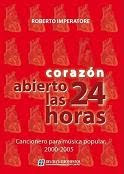 Back to The Shuttle's website.
Back to The Shuttle's website.
Literally, "Nunca Taxi" means "never been a cab", a phrase often used when selling a car. At Libario bar, Buenos Aires, lining up Agustín Cosovschi, Esteban Salonia, Gustavo Váter and Sebastián Briganti, the NTs revealed that their music is making a quite interesting turn. A funky rythm base prevails now in both new creations and updated versions of earlier songs from their first EP "A las flores". Váter's bass guitar plays a protagonic role there, and Briganti displays the urgent beat of his lively bass-and-snare-drum work. A constant and grungie guitar strumming by Agustín and Esteban completes the band's original new sound. When away from the rythm base, Esteban's guitar usually undertakes the solos and Agustín's guitar the riffs and the phrases. In such environment, Agustín's leading vocals become more emphatic as he tells the lyrics' story with conviction.
Their performance at Libario, a couple of days after they qualified to the semifinals of the Estudio Urbano's "Bandas al Aire" radio contest, suggested that today two streams converge into NT's musical identity: the funky one ―that of the new songs or new versions― and the earlier EP's one ―the one they have been publicizing so far. Most visibly, NT's studio recordings reveal influences from Luis Alberto Spinetta and The Beatles. However, it would be unfair to limit parenthood just to those two names: traces of a broad range of illustrious predecessors can be found in the genetic map of these new artists. Agustín's voice modulations evoke "Flaco" Spinetta himself, Vox Dei, Arco Iris, and somehow, for sure, The Beatles. His voice and Esteban's match well in balanced vocal arrays.
Agustín remarks: "Actually, our music has at least three major affluents. The Beatles, Spinetta, the indie rock in the styles of Franz Ferdinand, The Strokes and other post-punk influences." On the Beatles side, Agustín mentions their songs 'Pequeño Percance' (with a Magical Mistery Tour flavour, one which Esteban sang McCartney-style at Libario), 'Perro Sebastián' (festive although slightly nostalgic), and 'Perfume'. Among the Spinetta-style songs, he points out 'A las flores' (it truly sounds Spinetta-like on the EP, with Esteban playing a jazzy guitar solo, but at Libario it was one of the songs that commanded the funk revolt), 'Rito Inicial', and 'Jazmín'. And among the indie rock-post punk themes, he quotes 'Falta poco' and 'Lucy' (the rockiest one, often the main course in Nunca Taxi's shows). "Besides", he says, "there are two funkier songs that I'd rather place, however, at the roots of Soda Stereo: 'Vuelto Pájaro', because I feel it's poppier, and 'La Mesa Verde', because I composed it when I was 17, and I used to listen a lot of Soda at that age."
He recognizes mutations too. "It wasn't our purpose to make a new version of none of the songs, but at the same time we are re-creating everything. We started to play with more funk and I took advange of my new Fender Telecaster to change my sound and play always with mid gain. So now I focus on only two sounds: a distorted, mid-gain sound, and a cleaner one I use on a spot basis. In part, that's why the songs sound rockier. We looked for a brit indie rock sound, we wanted to get closer to the post-punk and new wave sound. To get that, Vater often uses the pick and I benefit from the tin-like voice of the new Telecaster".
"La mesa verde" and "Lucy" make part of the single the NTs are now recording to document the band's new aesthetics. It will soon be listened at their myspace page.
 Back to The Shuttle's website.
Back to The Shuttle's website.
He recognizes mutations too. "It wasn't our purpose to make a new version of none of the songs, but at the same time we are re-creating everything. We started to play with more funk and I took advange of my new Fender Telecaster to change my sound and play always with mid gain. So now I focus on only two sounds: a distorted, mid-gain sound, and a cleaner one I use on a spot basis. In part, that's why the songs sound rockier. We looked for a brit indie rock sound, we wanted to get closer to the post-punk and new wave sound. To get that, Vater often uses the pick and I benefit from the tin-like voice of the new Telecaster".
"La mesa verde" and "Lucy" make part of the single the NTs are now recording to document the band's new aesthetics. It will soon be listened at their myspace page.
 Back to The Shuttle's website.
Back to The Shuttle's website.







